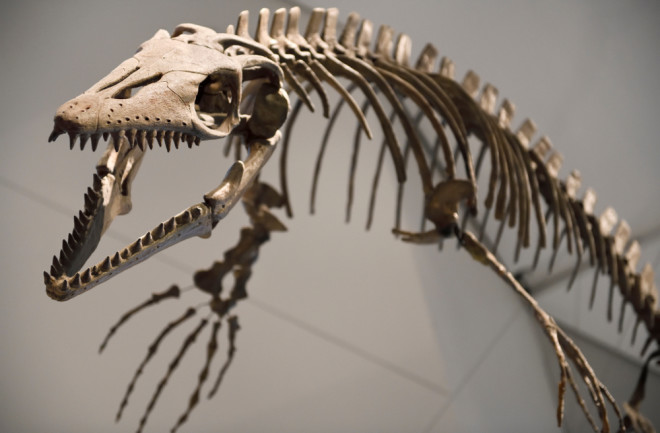The mythical dragons of folklore that spew fire and dwell on mountaintops have enthralled audiences for ages, but now scientists can tell the tale of a real-life “dragon” — a mosasaur called the Wakayama Soryu that lurked throughout the Pacific seas 72 million years ago.
Being the size of a great white shark, the Wakayama Soryu (Megapterygius wakayamaensis) would undoubtedly make an eye-catching first impression on anyone. Granted the name “Soryu,” which translates to “blue dragon” in Japanese, this creature commanded the ocean alongside other mosasaurs.
Takuya Konishi, an associate professor at the University of Cincinnati, spearheaded the task of classifying the mosasaur and chronicling its prehistoric rule. Konishi and a group of international co-authors recently published a description of the Wakayama Soryu in the Journal of Systematic Paleontology.
Akihiro Misaki, one of the co-authors, first discovered the specimen in 2006 at the Aridagawa River in Japan’s Wakayama Prefecture. As he was scouring the river for ammonite fossils, a dark bone embedded in sandstone caught his eye. An examination of the bone revealed it to be a vertebra belonging to a nearly complete mosasaur skeleton. A five-year removal process followed, in which researchers separated the sandstone from the fossils.
According to Konishi, it ended up being the most complete skeleton of a mosasaur ever found in Japan or the northwestern Pacific.
An Unprecedented Mix of Features
The specimen’s skeleton contained a combination of characteristics that was unlike anything ever seen in mosasaurs. Most notably, the Wakayama Soryu had four large flippers shaped like paddles that helped it navigate underwater: two in the front and two in the rear. The first part of its binomial name — Megapterygius, meaning “large winged” — takes inspiration from the flippers.
A medley of other features elevated this mosasaur beyond simple classification: a rudderlike tail, a crocodile-esque head, and the same dorsal fin found in certain whales made it an imposing predator.
The plesiosaur, another prehistoric marine reptile, used its similarly shaped fins for propulsion, but it did not have the same type of tail as the Wakayama Soryu. The “blue dragon” shares a few traits with other mosasaurs found in New Zealand and California, but its blend of features was largely met with bewilderment.
“We lack any modern analog that has this kind of body morphology — from fish to penguins to sea turtles,” Konishi said in a press release. “None has four large flippers they use in conjunction with a tail fin.”
According to a press release from the University of Cincinnati, researchers speculated that the front fins could have handled rapid maneuvering while the larger, rear fins were responsible for diving and surfacing. The tail, meanwhile, gave it the acceleration needed to easily catch prey.
“It’s a question just how all five of these hydrodynamic surfaces were used. Which were for steering? Which for propulsion?” Konishi said in the release. “It opens up a whole can of worms that challenges our understanding of how mosasaurs swim.”
Read More: 5 of the Most Interesting Prehistoric Marine Reptiles
What Were Other Mosasaurs?
The Wakayama Soryu has joined a pantheon of unique mosasaur species, some of which have also been unearthed and classified in recent years. One such newcomer is the Stelladens mysteriosus, based on fossils found in Morocco. Described in an article in the journal Fossils, this species was equipped with unusual teeth shaped like crosshead screwdrivers, raising questions about its diet compared to other mosasaurs.
The “blue dragon” isn’t the only mosasaur that alludes to draconic legend. Another recently discovered species, Jormungandr walhallaensis, takes its moniker from a sea serpent that plays a central role in Norse mythology. The species’ fossils were found near the North Dakota town of Walhalla in 2015.
Read More: Did This Giant Sea Lizard Rule the Oceans 66 Million Years Ago?
When Did Mosasaurs Become Extinct?
Mosasaurs and dinosaurs suffered the same fate when the Cretaceous period came to a disastrous end 66 million years ago. They both fell victim to the Cretaceous-Paleogene (K-Pg) extinction event, which marked the end of the line for 76 percent of species on Earth. Researchers commonly pin the blame on a colossal asteroid that crashed into modern day Mexico, instigating a climate catastrophe.
Drastic changes in the atmosphere may have spelled doom for mosasaurs by altering the entire aquatic food web. A 2017 study found a compelling explanation by examining calcium isotopes from fossilized teeth of Cretaceous-era marine vertebrates, including mosasaurs and plesiosaurs. A similar proportion of calcium isotopes in both groups signaled a food-driven rivalry between the reptilian predators.
At the onset of the extinction event, plankton species began to disappear. Large amounts of plankton-eating fish died off as a result, leaving mosasaurs and plesiosaurs to face eventual extinction due to a shortage of nourishment.
Although mosasaurs did not survive past the K-Pg event, their story has not fizzled out. Research on the Wakayama Soryu could prompt a deeper search into varied attributes of mosasaurs and the purposes they served. The classification done by Konishi and his colleagues has raised a fresh batch of questions about mosasaurs, proving that uncharted waters still lie ahead.
Read More: Fossils May Reveal a Clash of the Titans Between Two Undersea Reptiles

